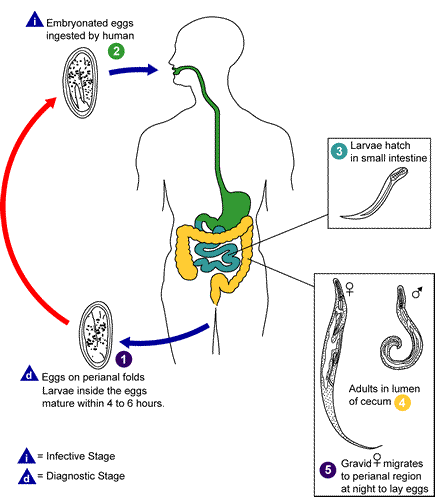Pinworms are one of the most common types of human worm infection. Worms require a host in order to survive, reproduce and complete their life cycle. In the case of pinworms, the human acts as the host.
Other names for this parasite include threadworm, seatworm, “itchy butt” worm and Enterobius vermicularis, or the common term ‘worms’. A pinworm infection is relatively harmless and can be easily treated.

Incidence
Human infestation by pinworms is more common in children as compared to adults. This is mainly attributed t the tendency of children to put their fingers into their mouth, due to which the pinworms can pass into their body. However, once a child is infected, other members of their household are also likely to get infected by the pinworms unless strict hygiene practices are observed.
Life Cycle of a Pinworm
The pinworms travel into the human body through the mouth. A child gets infected by the pinworms when he accidentally ingests the pinworm eggs. This can happen in cases where the child’s hands are contaminated and he puts his fingers in his mouth and gets infected. In other cases, a pinworm infestation can occur by the consumption of food contaminated with pinworms. In some cases, the pinworm infestation can also occur through clothes or contaminated bed clothing and other items contaminated with the pinworms.
Once a person gets infected with these pinworms, then the pinworm eggs travel to the intestine from the mouth. In the intestine, the pinworms lodge themselves and begin the process of maturation. The eggs of the pinworm hatch in the duodenum or the first part of the human intestine.
Once the pinworm matures, it becomes about 140 to 150 micrometers in size. It looks yellowish in color and has a slender appearance. The female pinworms have life span of 5 to 13 weeks, whereas the male pinworm has a lifespan of about 7 weeks. The male and the female pinworms then mate in the ileum or the last part of the human intestine. After the mating, the male pinworm dies and is passed out of the body through the stools.
Around a period of four weeks to 6 weeks after the ingestion of the eggs and human infestation, the adult female moves down the intestine. It then leaves the body via the anus in order to lay a batch of eggs on the surrounding skin. This often occurs at night. Once the major task of reproduction is complete, the female worm dies.
Children are more likely to reinfect themselves with the pinworm eggs
The eggs may cause intense itching of the anus and the surrounding skin especially at night. As the children scratch the skin around the anus, the eggs lodge themselves in the fingernails and on the skin of the fingers. So when the child puts the contaminated finger in his mouth, he infects himself again with the eggs. So the life cycle of the pinworms starts again, with eggs passing into the intestine, maturing, and laying eggs on the anus again.
1 thought on “What are Pinworms?”